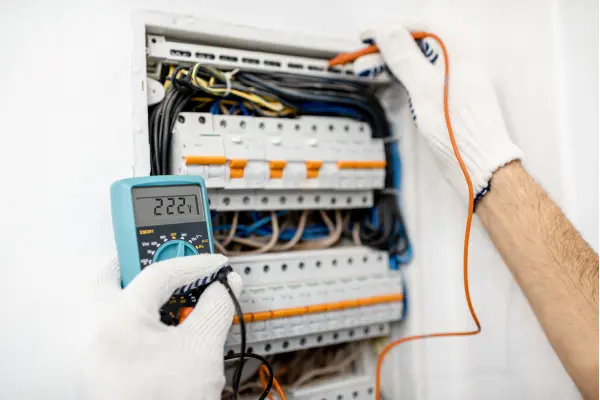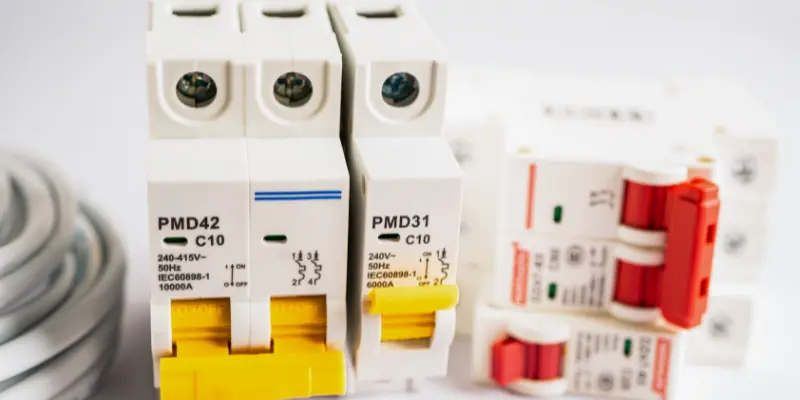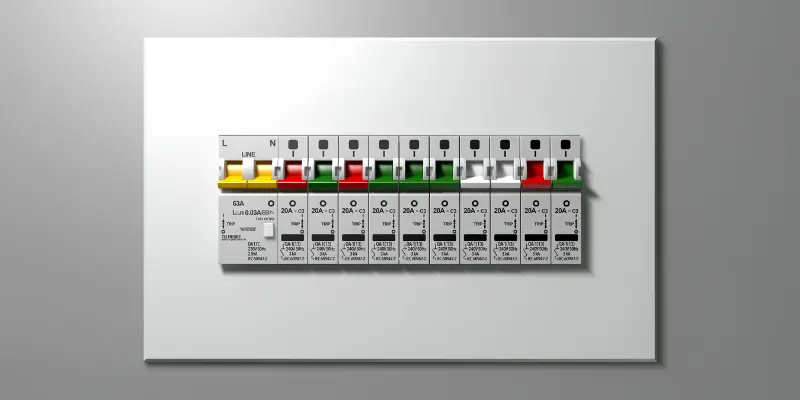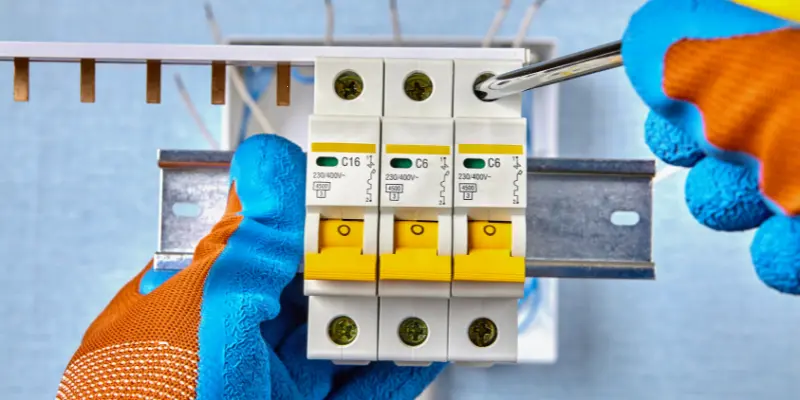Right Circuit Breaker Size for Electric Stove
Updated: 5 Jul 2025
239
Many homeowners don’t realize how important it is to match the stove with the right circuit breaker size. It’s not just about keeping the power on—it’s about protecting your home from electrical hazards.
Using the wrong breaker can overheat wires, damage your stove, or even cause a fire. Yet, this critical detail is often overlooked during kitchen upgrades. Whether you’re installing a new appliance or troubleshooting an old one, knowing the correct electric stove circuit breaker size is essential for safety and performance.
In this post, you’ll learn how to choose the correct circuit breaker size for your electric stove, how to calculate it based on wattage, what the NEC code says, and what happens if you get it wrong.
Understanding Electric Stoves and Circuit Breaker Requirements

Why a Circuit Breaker Matters
A circuit breaker is a safety device. It automatically shuts off electricity if the current becomes too strong. This prevents overheating, melting wires, and house fires.
For electric stoves, using the correct circuit breaker is not optional—it’s essential. An undersized breaker will trip often or even melt. An oversized breaker may not trip during a fault, leading to electrical fires.
Electric Stove Breaker Requirements
- Dedicated circuit only for the stove
- Voltage requirement: Usually 240V
- Breaker size: Depends on stove wattage
- Wire gauge: Must match the breaker’s amp rating
Types of Circuit Breakers Suitable for Electric Stoves
Different breaker types offer different levels of protection.
Standard Circuit Breakers
These are the most common. They protect against overloads and short circuits.
- Typically used for basic electric stoves
- Easy to install and replace
- Not ideal near water or moisture
GFCI (Ground Fault Circuit Interrupter)
These breakers protect against ground faults, like when electricity leaks through water or damaged wires.
- Required near sinks or wet areas
- Cuts power instantly if leakage is detected
- Offers shock protection
AFCI (Arc Fault Circuit Interrupter)
Protects against arc faults—when electricity jumps or arcs between wires.
- Detects small sparks before they become big problems
- Ideal for older homes or areas with frequent power fluctuations
- Some building codes require AFCIs in new kitchens
Choosing the Best Type for Your Stove
- Basic Setup? → Use a Standard Breaker
- Wet Areas or Code-Required? → Go with a GFCI
- Old Wiring or Extra Protection? → Choose an AFCI
Understanding Electric Stoves Power Consumption
Before you choose a breaker, it helps to know how your stove uses electricity. Most electric stoves range between 7,000 to 14,000 watts. That’s much higher than other kitchen appliances. To power this safely, your stove needs a dedicated 240V circuit and the correct breaker size.
Let’s break it down:
- Voltage = the pressure pushing electricity
- Wattage = how much power the stove uses
- Amperage = how much flow the stove needs
Use this basic formula to calculate amps:
Watts ÷ Volts = AmpsExample: A 10,000-watt stove on 240V
10,000 ÷ 240 = 41.6 amps → You’ll need a 50-amp breaker
National Electrical Code (NEC) Recommendation
But that’s not all. The National Electrical Code (NEC) recommends adding 25% extra for continuous load. This is why your circuit breaker size must not match the amp value exactly—it must be a bit higher to handle peak loads.
For more on NEC guidelines, visit the official NEC 2023 Code Book.
Make sure to also match your wire gauge with the breaker size. For example:
- 8-gauge wire = for 40 amps
- 6-gauge wire = for 50 amps
Want to know more about the power consumption of electric stoves? Check our post on Electric Stove Wattage: How Many Watts Does an Electric Stove Use?
How to Calculate the Right Circuit Breaker Size
Choosing the right circuit breaker size starts with a simple formula:
Watts ÷ Volts = Amps

Step-by-Step Calculation
- Step 1: Find the Stove’s Wattage
Look at the data label on the back of your stove or in the user manual.
Example: 10,500 watts - Step 2: Know Your Voltage
In most U.S. homes, electric stoves use 240 volts. - Step 3: Do the Math
10,500 watts ÷ 240 volts = 43.75 amps - Step 4: Add 25% Safety Buffer (per NEC code 210.19(A)(1))
43.75 amps × 1.25 = 54.69 amps - Step 5: Choose the Closest Breaker Size
Use a 50-amp or 60-amp breaker, depending on wire size and NEC allowances.
Quick Example Table
| Stove Power (Watts) | Amps Drawn | Breaker Size |
|---|---|---|
| 7,200 | 30 amps | 40 amps |
| 9,600 | 40 amps | 50 amps |
| 12,000 | 50 amps | 60 amps |
Why Matching Breaker and Wire Size Is Important
Many homeowners focus only on breaker size, but wire gauge is just as important. If the wire is too thin for the breaker, it may overheat before the breaker trips. That’s a serious fire hazard.
Breaker Size and Matching Wire Gauge
| Breaker Size | Minimum Copper Wire Size (AWG) | Notes |
|---|---|---|
| 30 amps | 10 AWG | For small ovens only |
| 40 amps | 8 AWG | Common for 8kW stoves |
| 50 amps | 6 AWG | Standard for most full-size electric stoves |
| 60 amps | 4 AWG | Rare; for commercial or oversized stoves |
Need help understanding wiring codes? Visit the official NFPA 70 – National Electrical Code for in-depth rules.

Different Stoves Require Different Breaker Sizes
Many people ask Do All Electric Stoves Use the Same Circuit Breaker Size? So the answer is simple. Not all electric stoves are the same. Depending on the type and features, the electric stove circuit breaker size will vary. Here’s a breakdown of the most common types and their needs.
Quick Comparison Table
| Type of Stove | Power (Watts) | Breaker Size | Notes |
|---|---|---|---|
| Freestanding Range | 8kW – 12kW | 40 – 50 amps | Only the oven draws electricity |
| Wall Oven (Double) | 6kW – 8kW | 40 amps | May need 2 circuits |
| Electric Cooktop | 3kW – 7kW | 30 – 40 amps | Usually on its own circuit |
| Induction Range | 10kW – 13kW | 50 – 60 amps | Requires heavy-duty wiring |
| Dual Fuel Range | 3kW – 6kW | 20 – 30 amps | Only oven draws electricity |
Want to know different stoves check out Different Types of Electric Stoves: A Comprehensive Guide
Do Electric Stoves Require a Dedicated Circuit?
Yes—100% they do. Every full-size electric stove must have its own dedicated 240V circuit, as required by the National Electrical Code (NEC).
Why a Dedicated Circuit?
- Electric stoves draw high current, especially during preheating and multi-burner use
- Shared circuits can overload easily
- Reduces fire risks and ensures smoother operation
Mistakes to Avoid and Safety Considerations

Even experienced DIYers often make simple but dangerous mistakes when sizing a circuit breaker for electric stove. These errors can lead to constant power trips, wiring damage, or even house fires.
Top Mistakes to Avoid
- Using a 30-amp breaker for a stove that needs 50 amps
- Matching breaker size to amperage without safety buffer (NEC requires 125% of continuous load)
- Ignoring the wire gauge and using thin wires
- Assuming all electric stoves use the same breaker size
- Reusing old wiring without checking its capacity
- Skipping the stove’s label and guessing the load
- Using extension cords or plug adapters for high-power appliances
- Installing the breaker in a shared circuit instead of a dedicated line
Safety Tips When Working with Electric Stove Circuit Breakers
- Always shut off power before working
- Use a voltage tester to confirm no current
- Follow National Electrical Code (NEC) guidelines
- Use a licensed electrician if unsure
- Don’t use aluminum wire unless rated and bonded properly
- Avoid loose connections—they cause overheating
Pro Tip:
After installation, run the stove at full heat for 15–20 minutes.
If the breaker trips, the setup may be undersized or wired incorrectly.
What Happens If You Use the Wrong Breaker Size?
Installing the wrong electric stove circuit breaker size may seem like a small issue—but the results can be serious.
If the Breaker Is Too Small
- It will trip constantly during cooking.
- It may shut off mid-cooking, causing frustration.
- Long-term tripping weakens the breaker.
If the Breaker Is Too Large
- It won’t trip when there’s a real overload.
- Wires can overheat silently, melting insulation.
- In extreme cases, this can lead to electrical fires.
Other Risks Include:
- Code violations during home inspections
- Failed insurance claims in the event of damage
- Appliance performance issues, like slow heating or flickering displays
FAQs
Can I use a 40-amp breaker for a stove that says 50 amps?
No. The breaker must meet or exceed the stove’s amperage requirements with a safety margin. Undersizing will cause constant trips and safety risks.
Is a 60-amp breaker too much for a 40-amp stove?
Yes, it can be dangerous. If wires aren’t rated for 60 amps, they won’t be protected. This can cause overheating or fire. Always match breaker size to wire capacity.
Can my stove and oven share the same breaker?
Only if they are designed that way. Most manufacturers require separate circuits for cooktops and wall ovens, unless they’re part of a combined unit.
Do induction stoves need a different breaker?
Yes, sometimes. Induction models are often more powerful and may require a 60-amp breaker, depending on features. Check the label before buying.
Conclusion
Choosing the right circuit breaker size for electric stove is more than a technical step—it’s a safety decision. Using the correct circuit breaker size ensures your stove runs smoothly, safely, and efficiently. It also helps your home stay code-compliant and future-proof.
As the saying goes: “Electricity doesn’t forgive mistakes.” So be sure to choose the right protection.
Using the correct circuit breaker size for your electric stove helps protect your home and keeps your kitchen running smoothly. Stay safe, follow NEC codes, and never take shortcuts when it comes to electricity.
References
https://www.nfpa.org/codes-and-standards/nfpa-70-standard-development/70
https://diy.stackexchange.com/questions/207936/50-amp-circuit-breaker-for-a-30-amp-electric-oven
Please Write Your Comments